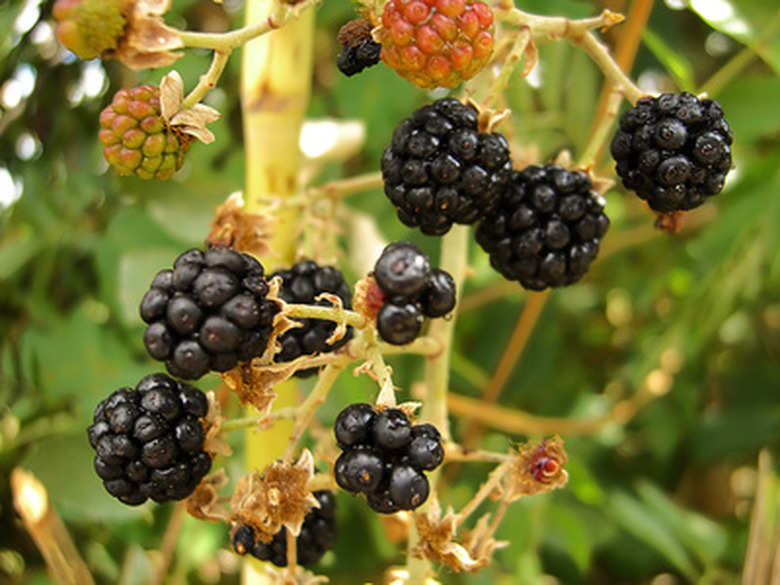Mulberry Tree Pests & Diseases
Widely planted and naturalized in the eastern part of the United States, mulberry trees (Morus alba spp.) are large, fruit-bearing deciduous trees which can grow 60 feet tall with an equal spread, although they can be trained to a smaller bush with frequent pruning. They grow rapidly and will survive in virtually any type of soil except wetlands. They withstand drought, pollution, salt spray, compacted soils and urban conditions well. Small berries that start out white, turn a deep blush red and finally ripen to deep purple begin to mature in mid summer and continue for weeks. Mulberry trees planted near a sidewalk or street can make a mess with its fallen fruit. Choose the planting site carefully.
- Widely planted and naturalized in the eastern part of the United States, mulberry trees (Morus alba spp.)
- are large, fruit-bearing deciduous trees which can grow 60 feet tall with an equal spread, although they can be trained to a smaller bush with frequent pruning.
Scale
Mulberry trees are susceptible to armored scales (Diaspididae spp.) that attach themselves to twigs and leaf stems. These armored scales have a hard, protective coating which protects them from pesticides. This makes them hard to eradicate with traditional pesticide sprays. Frequent inspection of the young twigs and leaves will catch an infestation early. Look for raised bumps with a light tan or gray color in the susceptible locations. A strong spray from a hose may be enough to knock them off the tree. Spray weekly for several months for the best chance of reducing scale populations on your mulberry tree.
- Mulberry trees are susceptible to armored scales (Diaspididae spp.)
- Spray weekly for several months for the best chance of reducing scale populations on your mulberry tree.
Mealybugs
Slow plant growth, twig dieback and premature leaf drop are all symptoms of the several species of mealybugs (Pseudococcus spp.). You may also notice a white cottony mass on young twigs and leaves of your mulberry tree. Mealybugs quickly grow to large populations and prefer to congregate in these large numbers, which forms the cotton-like mass on mulberry trees. Sticky honeydew is a byproduct of infestation and will cover the ground and objects beneath the mulberry tree. Natural predators of mealybugs, such as the mealybug destroyer, Cryptolaemus montrouzieri, are the most effective means to eradicate a mealybug infestation. Other methods include a strong spray from the hose, consistently applied, which will knock them off the host tree. Horticultural oil spray can also be effective, as can systemic insecticide applied to the soil in the tree's root zone.
- Slow plant growth, twig dieback and premature leaf drop are all symptoms of the several species of mealybugs (Pseudococcus spp.).
- Mealybugs quickly grow to large populations and prefer to congregate in these large numbers, which forms the cotton-like mass on mulberry trees.
Bacterial Blight
Black or brown irregular spots on leaves that wilt and turn brown; blossom and tip dieback; lesions on flowers, fruits and stems; and brown streaks in the wood are all symptoms of bacterial blight (Pseudomonas syringae), a common bacterial infection of mulberry trees. Bacterial blight is most prevalent in prolonged, rainy springs, with the wettest areas showing the most extensive symptoms and infections. Spraying does not reliably control bacterial blight and the best defense is to remove affected branches. Prune out these affected branches during dry weather; wet, rainy weather will further spread the disease. Do not overfertilize affected plants and water only at soil level. Mulberry trees with bacterial blight damage that is confined to the leaves and small twigs will usually recover, providing affected branches are pruned off. If cankers appear on the mulberry's trunk, it will most likely not recover and you should remove the tree.
- Black or brown irregular spots on leaves that wilt and turn brown; blossom and tip dieback; lesions on flowers, fruits and stems; and brown streaks in the wood are all symptoms of bacterial blight (Pseudomonas syringae), a common bacterial infection of mulberry trees.
- Mulberry trees with bacterial blight damage that is confined to the leaves and small twigs will usually recover, providing affected branches are pruned off.
